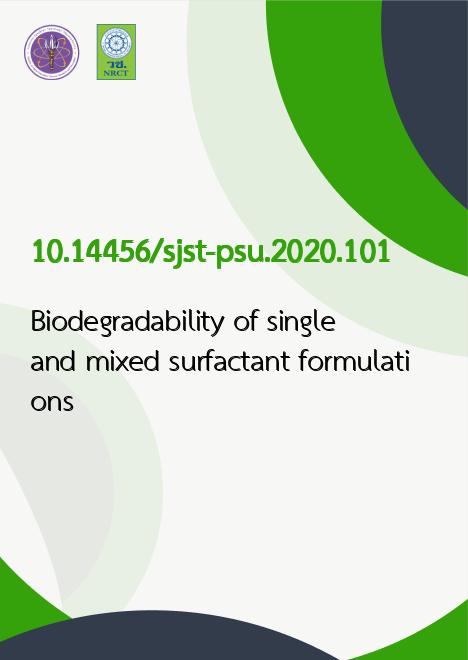
|
Biodegradability of single and mixed surfactant formulations |
|---|---|
| รหัสดีโอไอ | |
| Creator | 1. Jarrent R. Tayag 2. Ronaldo M. Fabicon |
| Title | Biodegradability of single and mixed surfactant formulations |
| Publisher | Research and Development Office, Prince of Songkla University |
| Publication Year | 2563 |
| Journal Title | Songklanakarin Journal of Science and Technology |
| Journal Vol. | 42 |
| Journal No. | 4 |
| Page no. | 788-794 |
| Keyword | surfactant biodegradation, surfactant combinations, waste water treatment |
| URL Website | https://rdo.psu.ac.th/sjstweb/index.php |
| ISSN | 0125-3395 |
| Abstract | Even though detergent surfactants are mandated to be biodegradable, the environmental fate of these surfactants whenmixed together in bodies of water is still not established. The study aimed to determine the biodegradability of NaLAS/CTABsurfactant combinations by measuring the amount of evolved CO2 which was measured using the OECD 301b procedure. The90/10 and 10/90 NaLAS/CTAB systems showed a decline in biodegradation behaviors which were recorded as 55.88% and40.12% biodegradation, respectively, after a 28-day monitoring period. Conductivity results revealed changes in the availabilityof ions in the system. An inflection point was observed at a CTAB concentration of 700 ppm. The highest turbidity was noted ata NaLAS/CTAB molar ratio of 1.39:1 which indicated the formation of insoluble catanionic salts in the system. Conductivity andturbidity testing revealed the formation of anionic-cationic structures such as micelles and ion-ion complexes. These structuresmay alter the natural degradation mechanism of microorganisms, thus leading to the slower rate of biodegradation or incompletedegradation of the surfactants. |
